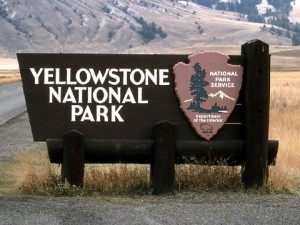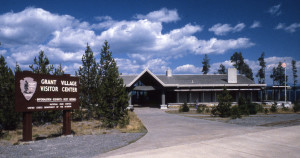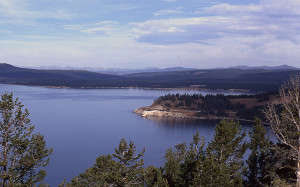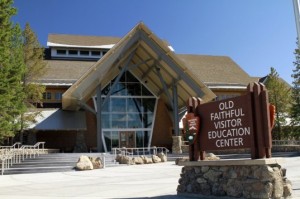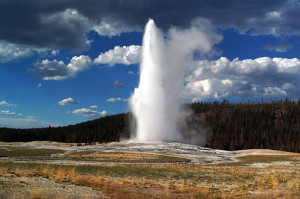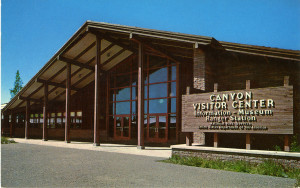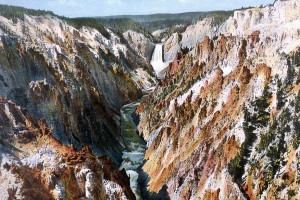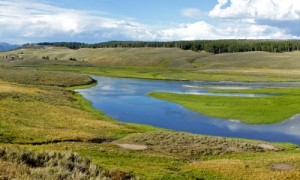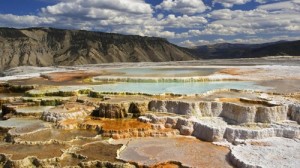Yellowstone National Park is one of the most popular National Parks in the United States. On a family trip to Wyoming several years ago and we had a wonderful road trip seeing the Grand Teton National Park, Jackson Hole where we ate buffalo burgers, Cody where we went to a rodeo and Yellowstone Park. Yellowstone offers visitors beautiful scenery from majestic mountains and waterfalls, lakes and streams, geysers and hot springs. Visitors can enjoy a variety of outdoor activities and when the day is done there are numerous places to stay overnight ranging from camp sites, rustic cabins or lodge accommodations. In this Travel Post, I will discuss the history of the park, general visitor information for planning a visit and a list of things to see and do.
The history of Yellowstone National Park
The Yellowstone Caldera (a large depression resulting from the explosion or collapse of the center of a volcano) which covers the northwestern portion of Wyoming and most of the area of Yellowstone National Park was formed about 640,000 years ago by a series of violent volcanic eruptions displacing massive amounts of volcanic material and land mass which created a large depression. The Yellowstone Caldera which was created, by what is referred to as the “super-volcano”, is approximately 3260 feet deep and covers an area that extends 45 miles long and 28 miles wide. With each subsequent volcanic eruption that occurred throughout millions of years large amounts of ash and gases were released into the earth’s atmosphere over much of central North America and this caused drastic changes in weather patterns that ultimately lead to the extinction of several species of animals. After the last “super-eruption” and subsequent smaller eruptions between 640,000 to 70,000 years ago, a lava stratum (a layer of sedimentary rock) was deposited over a period of time to fill the U-shaped area which had been created. Later the area continued to be altered when water erosion from the Yellowstone River and its tributaries carved deep V-shaped valleys.
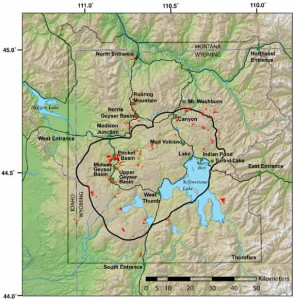 It has been scientifically documented that there remains a large magma chamber beneath most of the area of Yellowstone National Park which is approximately 27 miles long, 18 miles wide and between 3 to 7 miles deep. As a result, geothermal activity in the area is constant with over 1200 geysers that have been recorded within the park, 465 are currently active.
It has been scientifically documented that there remains a large magma chamber beneath most of the area of Yellowstone National Park which is approximately 27 miles long, 18 miles wide and between 3 to 7 miles deep. As a result, geothermal activity in the area is constant with over 1200 geysers that have been recorded within the park, 465 are currently active.
Over 11,000 years ago the Paleo Native Americans lived in the region (as previously mentioned in the Grand Teton National Park Travel post, please click on the link for more information) In 1806, John Colter, who had been a member of the Lewis and Clark Expedition, traveled through the area now known as Yellowstone National Park, he encountered the Shoshone Native Americans and made note of the geothermal conditions in the region. Mountain men continued to frequent the area to fish, hunt and trap the abundant wildlife.
In 1870, an expedition headed by Henry Washburn with Nathaniel Langford to explore the Yellowstone area. A Montana writer named Cornelius Hedges was a member of the expedition and he started writing articles for the Helena Herald about the beauty of Yellowstone River and the Great Geyser Basin and urging that these areas needed to be protected. Others became involved such as William Henry Jackson, a photographer, and Thomas Moran, a painter, who worked with the Hayden Geological Survey team in 1871 that submitted a report to the U.S. Congress. Eventually President Ulysses Grant signed the Act of Dedication on March 1, 1872 which created Yellowstone National Park.
In the initial years of the parks existence the U.S. Army was commissioned to oversee the administration and maintenance of the park until 1917 when it was transferred to the National Park Service which had been created in August 1916. By that time, the former horses and carriages were replaced by automobiles. Between 1933 and 1942, the Civilian Conservation Corps (CCC) which was part of President Franklin Roosevelt’s New Deal policy built park facilities such as visitor centers and campgrounds, constructed park roads and hiking trail and participated in a reforestation plan.
During World War II, tourism fell dramatically and as a result park staff was reduced and the building, roads and trails fell into disrepair. By the 1950s, the nation was recovering from the war and the park’s facilities were rebuilt to accommodate the increased amounts of visitors. Today, Yellowstone National Park has an average of 3.5 million visitors annually making it one of the ten most visited National Parks in the United States.
Yellowstone National Park Visitor Information
Yellowstone National Park covers an area approximately 3,468 square miles in the northwest corner of Wyoming with a small portion in Montana and Idaho; it became the first national park in 1872. Yellowstone was formed by a “super-volcano” that created the Yellowstone Caldera and the park features lakes, rivers, mountains, canyons, geysers and an abundance of wildlife. The French trappers that frequented the area called the river “Roche Jaune” which loosely translates in English to Yellow River probably referring to the yellow stone or rock that can be seen in the canyons carved by the river in a place now known as the Grand Canyon of the Yellowstone.
Yellowstone National Park has numerous activities available for visitors and a variety of accommodations ranging from campsites and rustic cabins or lodges within in the park. (Travel Tip: I would advise making reservations as early in advance as possible especially if you are planning a trip during the busy summer months)
South Entrance
Grant Village is about 22 miles from the South Entrance to Yellowstone National Park and it is located on the southern part of Yellowstone Lake in an area known as the West Thumb. Grant Village has a visitor center, camp ground, lodge, cabins, shops and restaurants. The West Thumb Ranger Station is a great place to get information regarding activities in the park and is the meeting place for ranger-led interpretive walks and presentations. While in the Visitor Center, be sure to check out the film on the 1988 Yellowstone Fire. (For more information on the devastation caused by the fire, please click on the link to Yellowstone National Park – Part Two)
Travel Advisory: Please be careful in this area of the park because it is frequented by bears that come to fed on the trout in the lake and streams so please store food properly and be aware of the potential hazards.
Yellowstone Lake –
Yellowstone Lake is the largest lake in Yellowstone National Park; it is 7,732 feet above sea level and covers 136 square miles with an average depth of 139 feet and the deepest part is 390 feet. In the winter the lake can freeze over except in the shallow waters along the shoreline where there are hot springs. Throughout the years there have been multiple proposals to construct dams in the area of Yellowstone Lake as a means of controlling water drainage; eventually these proposals were all defeated. There is great fishing in Yellowstone Lake and boating is allowed but special permits are needed for both activities.
West Entrance
Old Faithful Village/Visitor Center –
The Old Faithful Village is about 30 miles from the West Entrance to Yellowstone National Park and is located in an area known as the Geyser Basin. Old Faithful Village has a visitor center, camp ground, lodge, cabins, shops and restaurants. Be sure to take time to visit the Old Faithful Visitor Center which features exhibits pertaining to the geothermal conditions of the park. Also while at the Visitor Center check the estimated times of the geyser eruptions.
Old Faithful Geyser –
Old Faithful Geyser is located the Geyser Basin of Yellowstone National Park, the area is an active geothermal region. Old Faithful was given the name in 1870 by the Washburn Expedition because of the geyser’s very predictable pattern of eruptions; eruptions take place on the average every 90 minutes. A normal eruption lasts between 1 to 5 minutes with approximately 4,000 to 8,000 gallons of water soaring up to heights of 180 feet. Travel Note: Old Faithful Geyser is a short walk from the Old Faithful Inn, there are several viewing benches at the observation point but arrive at least 15 minutes prior to an eruption and check the schedule for anticipated times.
Old Faithful Inn –
Located near the Old Faithful Geyser is the Old Faithful Inn which is the largest log structure in the world, the lobby has an 80 foot ceiling and massive stone fireplace. The Inn was finished in 1904 and was built in an architectural style known as “National Park Rustic” with exterior and interior framing supported by thick lodgepole logs. The east wing of the Inn was added in 1914 and the west wing in 1927, it was designated a National Landmark in 1987. Travel Tip: The Inn has a large dining room adjacent to the lobby, be sure to make a reservation in advance to enjoy a relaxing meal before or after viewing the Old Faithful Geyser.
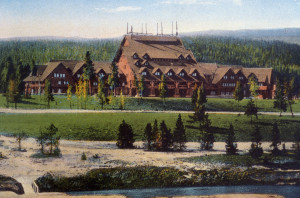
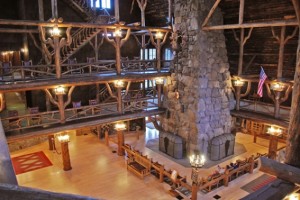
Central area of Yellowstone National Park
Canyon Village/Visitor Center –
The Canyon Village is located in the center portion of Yellowstone Park, 40 miles from the West Entrance and 43 miles from the East Entrance. Canyon Village has a visitor center, camp ground, lodge, cabins, shops and restaurants. The Canyon Visitor Center features exhibits about the geology of the park and focuses on the “supervolcano” which created the Yellowstone Caldera.
The main feature in the area is the Grand Canyon of the Yellowstone which is accessible to visitors from one-way loop road with overlooks and short hikes to scenic viewpoints. The auto tour starts from the Visitor Center by driving along the North Rim Drive with stops at Inspiration Point, park and get out of the car to walk down steps to an overlook to view Lower Falls. Another stop is Grand View where ospreys can be seen in the summer months and Lookout Point with another view of Lower Falls. At Upper Falls View there is a short .3 mile trail from the parking lot to an overlook with a spectacular view of the waterfall, listen closely to hear the power of the river rushing below.
Travel Advisory: Be sure to take walks and hikes slowly if you have any health issues because the high altitude of almost 8,000 feet can affect people with high blood pressure, heart and lung problems.
Grand Canyon of the Yellowstone –
The Grand Canyon of the Yellowstone is 24 miles long and reaches a depth of 1,200 feet and 4,000 feet wide. The canyon was formed about 600,000 years ago after the Yellowstone “supervolcano” erupted causing a massive caldera. The region was further changed by a series of seismic activities which uplifted portions of the area and then later a deep V-shaped valley was carved by years of water erosion creating the deep canyon that is seen today. As the Yellowstone River flows down the canyon there two waterfalls, the Upper Yellowstone Falls is 109 feet high and about a quarter mile downstream is the Lower Yellowstone Falls which is 70 feet high.
Travel Tip: I highly recommend a leisurely drive in Hayden Valley located near Canyon Village. I would suggest either going in the early morning or in the evening before the sunsets because that is the best time to view the wildlife in this area of Yellowstone. (For more information about the variety of animals seen in the park, please click on the link to Part Two of the two part series on Yellowstone National Park)
North Entrance
Mammoth Hot Springs –
Mammoth Hot Springs is located only 5 miles from the North Entrance to Yellowstone National Park and the city of Gardiner, Montana. The North Entrance is the location of the Yellowstone National Park Headquarters which uses many of the building from the original Fort Yellowstone. Fort Yellowstone was a U.S. Army post that was established in 1891 to administrate and manage Yellowstone National Park; by 1918 these duties were transferred to the newly created National Park Service. The Roosevelt Arch was constructed in 1903 at the North Entrance to the park and is named for President Roosevelt who laid the cornerstone for the arch. Located in the Mammoth Hot Springs area is the Albright Visitor Center, it is the largest Visitor Center in the park and is a great source for park information and there is also exhibits explaining the park’s history throughout the years, there also a short film and a wildlife museum upstairs. Mammoth Hot Springs Hotel is located nearby and it is the winter base for many winter activities such as snowmobiling and cross-country skiing.
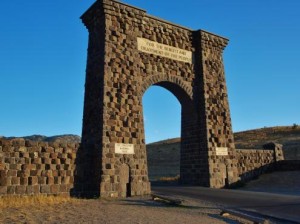
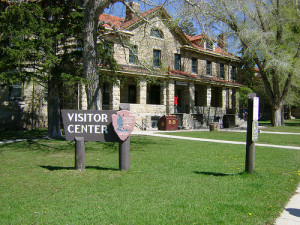
Mammoth Hot Springs Terraces –
The Mammoth Hot Springs Terraces were formed almost 600,000 years ago after the collapse of the “supervolcano” that created the Yellowstone Caldera. The Mammoth Hot Springs Terraces are a result of heat and water escaping through limestone rock fissures in the surface of the earth. Beneath the area is a large magma chamber which is all that remains of the ancient volcano and this is what supplies the heat that created the terraces. The water is supplied by annual rain and snow which seeps into the earth and is heated by hot carbon dioxide gases coming from the magma chamber. The water becomes extremely hot water mixed with the limestone that forms a carbonic acid solution that is then released back to the surface through geysers or hot springs. Once the water is exposed back into the open air the carbon dioxide evaporates and solid calcium carbonate mineral remains forming terraces that are covered in algae that provide the wonderful colors ranging in shades of brown, red, orange, yellow and green.
Travel Tip: Visitors can access the Mammoth Hot Springs terraces from the Upper Terrace Drive Loop Drive but I would advise parking the car, getting out and walking on the wooden boardwalks located around the area. The colors of terraces can changed frequently so don’t be surprised if they look very different from the photos. Also bison and elk do frequent the area and you might be lucky and see a few!
The North-East Area of Yellowstone National Park
The Tower/Roosevelt Ranger Station is located 23 miles from the North Entrance to the park or 29 miles from the North-East Entrance near the town of Cooke City at the Wyoming/Montana boarder. The Tower/Roosevelt Ranger Station is one of the last outposts from the time that the U.S. Army management of the park. The Roosevelt Lodge is located in this area; the lodge includes rustic cabin accommodations for guests and a dining hall with a bar. Another option for guests at the Lodge is the Old West Cookout that is served outdoors; guests arrive by horseback or on a wagon. Also located in this part of the park is a camp ground, a store and a gas station.
About 2 miles east of the Tower Junction is a fossilized forest, the 40 square miles of petrified forest was created between 45 and 50 million years ago when the area was covered in volcanic ash repeatedly over 25 different times. Further down the road is the 130 foot Tower Fall, it was Thomas Moran’s famous painting of the Tower Fall that helped to establish Yellowstone National Park in 1872, another nearby area which was painted by Moran was the Calcite Springs.
Lamar Valley, located not far from the Tower/Roosevelt Ranger Station is another great place in Yellowstone like Hayden Valley for wildlife viewing, especially in the early morning hours or the evening hours before the sunsets. In the Lamar valley bison and elk are most often seen and less frequently seen are wolves, coyotes and grizzly bears. Lamar Valley is also the area where the wolves were re-introduced into Yellowstone National Park after a long absence from the park. The Lamar River that flows through the valley is a popular destination for fly fishing.
Special Note: Please click on the link for Part Two of the two part series on Yellowstone National Park for information regarding the park’s wildlife including the bear population that was effected by the visitor’s demand for entertainment and the large herds of elk that pass through the park annually. Also I will discuss the 1988 Yellowstone fire that set precedence for future NPS fire policy and 1995 re-introduction of the gray wolves to the park.
Also, be sure to check out the other Travel Post this month about nearby Grand Teton National Park, just click on the link.

